In a fine
article called "Brave New World", Mountain Magazine (#31, 1973)
and Jim Bridwell
had this to say about the Left Side of the Hourglass:
The Left Side of the Hourglass, a work of genius by Peter Haan, remains one of the most respected leads of the day. One thinks of the potential fifty-foot fall while leading the overhanging, 5.10 off-width crack after the undercling. This single lead, with its 5.10 hand crack to 5.10 undercling to a 5.10 off-width, all without resting spots, makes the overall rating 5.11, and earmarks the accelerative pitch - in imagination.
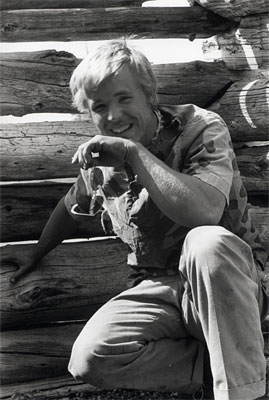 The
Left Side of the Hourglass:
The
Left Side of the Hourglass:
recollecting the first free ascent.
©Peter Haan, June, 2006
___Much
earlier version published in Adventure Journal spring, 2000. It was the summer
of 1971 a year after the National Guard had seized Yosemite Valley briefly
during the Stoneman Meadow Fourth of July riots. The Guardsmen had stood menacingly
at the park entrance with their deadly rifles for a couple of days, while
the innocent paradise which they presumed themselves to be guarding behind
them, eternally and indifferently towered on.
___For a decade already, the country had been
gripped simultaneously by an historic battle for civil rights and a terrible
war in Southeast Asia. These struggles permeated everything. I had been out
of college since 1970 climbing a tremendous amount at most every opportunity
except for wintering in Santa Cruz for my other passion, the big surf. I had
escaped the draft via a hernia which remains to this day incipient. Without
knowing my diversion would be so easy, I had been preparing to defend a conscientious
objector’s position; if need be, lighting out for Canada. And then suddenly
I was free, and took to the mountains.
___My first solo ascent of the Salathe Wall in
July of that year confronted me with life’s big questions. The El Capitan
solo had been a massive undertaking and experience. I had arrived on the summit
having shed 5-1/2 days and twenty pounds, briefly able neither to recognize
my friends, Bridwell and Klemens, nor understand the expressions on their
faces. And yet I was still powerful and thought I could go onwards and upwards,
forever. I had not seen a human for what seemed a lifetime; I had nearly left
everything behind. I had begun a personal transformation. Level ground was
also strange after so many days in the realm of the vertical; reaching the
top, I was also content to finally stop ascending and quietly walk away, and
what seemed magically, tread softly into the primeval forest towards my home,
an aging VW bus temporarily parked by Bridwell for us a few miles away at
a remote campground above the rim of the Valley. In the ensuing weeks my strength
returned while I was shedding the bark-like skin and calluses from my brutalized
hands, and the fear that nothing had really changed began again. So my gaze
was lifted once more, to what, I didn’t know. It was also a question
of creativity: what could I see in this art that others had not?
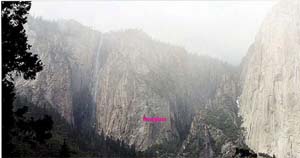 ___This
vertical rock world of Yosemite, for all its natural violence, sublime drama,
and world-class human provincialism, symbolized more and more, how I actually
felt inside. Very little was comfortable and the beautiful granite shrieks
surrounding me had come to symbolize something more than lifeless random features
of the natural world.
___This
vertical rock world of Yosemite, for all its natural violence, sublime drama,
and world-class human provincialism, symbolized more and more, how I actually
felt inside. Very little was comfortable and the beautiful granite shrieks
surrounding me had come to symbolize something more than lifeless random features
of the natural world.
___On my rest days, lying by the river in the
mother sun, I could find simple joy for a few hours and such days seemed as
if this must be how life should play out, idling upon a river beach with all
the time in the world; in a world that loved me and went on forever. But within---just
below the surface---still worked away a strange young agony, terrible longing
and sense of unbelongingness that had been subtly mounting for years and would
not stop. And I could recognize this obsessive dilemma in many of my other
climbing colleagues. It was pushing me towards some unknown but exquisite
edge, my body some fine instrument, longing and preparing in its peak years
to play its own ultimate ferocious music upon those Valley walls. And in my
personal life, I was unloved, unpartnered, sleeping alone, really adrift in
society uncherished, a strong young thing in pain, marginalized.
___When at the age of 23, I then made the first
free ascent of the left side of the Hourglass later that Fall, this little-known
but gorgeous aid climb quietly became the first or second unrehearsed 5.11
free climb in Yosemite and American history. Done 32 years ago, this dangerous
ascent was climbing that has rarely been seen in America but was nonetheless
very expressive of those times. ___Hopefully
this highly detailed and emotionally unusual recollection will capture the
spirit of that strange, bold era and some of the private, termitic moments
that occurred to many of us after the Golden Age of Yosemite Climbing had
subsided, during those nebulous few years leading into what Bridwell titled
in his article from that dawning period, "The Brave New World" of
current modern climbing. Understand that our sport and art had reached a certain
critical mass given the simple equipment and frankly primitive techniques
we had and several of us were making ultimate efforts, living in deepest commitment,
searching, not just slothfully hiding in a subculture stunned and powerless.
___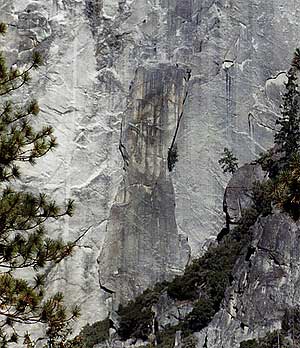
Without knowing it, our efforts had their context, really, in the
Beat movement and the angst of our enormous social and political struggles
of the time; and in those days very very few people, and mostly just men,
were climbing. Hardly any serious climbers had interest in material things
or fame. Many of us lived in our crummy old cars, campers, and tents year
around. It did not matter what we had, but only what we were doing with our
time here on earth and as far from authority and a laughably banally corrupt
modern civilization as possible, with Yosemite promising to be our spiritual
center towards which to kneel. There it was, practically a heaven on Earth,
originally a long-kept secret of the Indians until the mid-nineteenth century.
In the previous decades, these same beliefs, freshly thrashed by the experience
of the two World Wars, had been the origin of the Beat movement, spawning
a really poignant phase of American art, music and literature.
___This was also the beginning of modern speed
climbing and the radical unroped free-soloing movement that really flourish
today. Soloists had discovered along the way that by transcending equipment---leaving
it all behind and just simply climbing with shoes and a chalk bag, they climbed
at their critical peak and much was revealed to them only in this way. Imagine
the excruciating aesthetics and vistas, from thousands of feet above, while
completely shorn of equipment! It was long before cams, ingenious wide crack
protection, and sticky shoes; long before climbing comfort and protocol finally
became almost oppressive and perhaps now masking a few of the secrets past
eras had discovered. For decades, progress in the climbing art was not towards
safety (as it later turned out to emphasize so strongly) but into ever more
transcendent flights of self-risk and existential knowledge with less and
less equipment, more and more awareness and inexplicable power.
___After my ascent, and typical of other climbers
before me, the accomplishment and rite of passage were partly why I could
finally bow out of the central camp scene and its infinite loop of harder
and harder climbing. I especially was thinking of Gervasutti and Terray. So
at last I could be released from its interminable social struggles and the
great trouble that being in the vanguard spelled for each of us. Perhaps thus
enlightened, I turned to new thoughts and still deeper ways of looking at
my life, as my youth ended. You have asked so here is my story. Here for the
first time in the many seasons that have intervened, I have finally written
about this moment in my early years and what took place, unknown to the rest
of the world that quiet afternoon in September 1971, in an obscure little
spot at the edge of the forest near Ribbon Falls. This radiant, complex, and
astounding memory has since been with me privately almost every hour and in
ways served for me as an armature for so many situations to come, even though
three decades have transpired, and my powers have subsided and I have long
since disappeared from the central climbing scene.
___
___In the second year of my climbing and already truly committed
to the sport, I had found a way to organize and approach life that would be
entirely my own while growing up in Berkeley. Basically a fifteen-year-old
climbing fanatic already disinterested in the social gyrations of that era
and yet probably mirroring them, I was taken to the Hourglass, a gorgeous
350-ft tall, uniquely monolithic flake on the vertical wall of the Ribbons
Falls East Buttress. It was 1964; the huge Valley faces floating ethereally
and mass-less around us truly terra incognita, completely mysterious and mostly
unclimbed. And for me, it was my first real encounter with advanced climbing,
hanging belays in bay trees, bright orange overhanging cracks, gigantic polished
granite walls, and even the curious, powerful fragrances of these nearly sacred
places.
___ Frank Sacherer had recently freed the imposing
right side aid route but this drew little attention.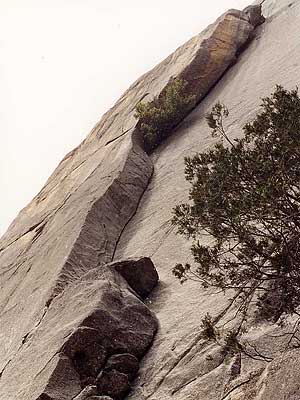 Les Wilson and Max Heinritz who really liked obscure nailing adventures, wanted
to climb this feature out in the boondocks still entirely by aid with weird
devices we had invented, called Crackjacks! The effort of course was completely
a personal outing of ours with no relation really to what was actually developing
in American climbing. I remember now nearly forty years later, walking by
the even more dramatic left side route then and thinking as a fifteen-year-old
does, here was where the real climbers had been. This left side was a notorious
A4 aid route of great difficulty and peril in that the first pitch with the
wide cracks and big roof in those days had to be nailed for many feet with
pairs of bongs back-to-back, crosswise, and slung; it was an enormous house
of cards. Bob Kamps, the first ascent leader, was a formidable climber and
worked on this pitch forever obviously in a great deal of peril. I think it
might have even gone on for more than one day. Pratt proclaimed in the late
60's this route was the last remaining important free climbing problem in
Yosemite. Although he was hugely wrong, the statement surely places this climb
in context. I am not even sure if it had had a second aid ascent before my
party appeared to climb it free one morning, nine years later. This majestic
climb had been completely ignored for the thousands of other climbs closer
in. And yet I had seen it, and begun to identify with it, all by itself out
there in the woods.
Les Wilson and Max Heinritz who really liked obscure nailing adventures, wanted
to climb this feature out in the boondocks still entirely by aid with weird
devices we had invented, called Crackjacks! The effort of course was completely
a personal outing of ours with no relation really to what was actually developing
in American climbing. I remember now nearly forty years later, walking by
the even more dramatic left side route then and thinking as a fifteen-year-old
does, here was where the real climbers had been. This left side was a notorious
A4 aid route of great difficulty and peril in that the first pitch with the
wide cracks and big roof in those days had to be nailed for many feet with
pairs of bongs back-to-back, crosswise, and slung; it was an enormous house
of cards. Bob Kamps, the first ascent leader, was a formidable climber and
worked on this pitch forever obviously in a great deal of peril. I think it
might have even gone on for more than one day. Pratt proclaimed in the late
60's this route was the last remaining important free climbing problem in
Yosemite. Although he was hugely wrong, the statement surely places this climb
in context. I am not even sure if it had had a second aid ascent before my
party appeared to climb it free one morning, nine years later. This majestic
climb had been completely ignored for the thousands of other climbs closer
in. And yet I had seen it, and begun to identify with it, all by itself out
there in the woods.
___The
three of us arrived at the base of this dramatic feature, after an hour balancing
up the steep talus, past hulking malodorous bear caves and through the many
oaks shielding an overwhelming view of an enormous glistening cliff ahead.
We had been skirting the creekbed that runs from the thunderous and deep 1000-foot
portal of Ribbon Falls; hardly anyone ever goes up here---the other cliffs
closer to the road get all the attention. The feeling of autumn had not quite
come, but the suffocating heat of a Valley summer had just left a few days
ago. It had been a really big year for me, and I was deeply wondering about
so many things. I was even tired of it all, dispirited, with nowhere to go,
and yet paradoxically climbing at my very peak. My powers had never been greater.
Was climbing colorful enough to make a whole life? Could I just go from here
and fill up the rest of my years with this art? I was no longer certain, but
had counted on climbing to mean everything important; it was beginning to
seem that the center did not hold (Yeats) and all kaleidoscopically gyrated
away into where?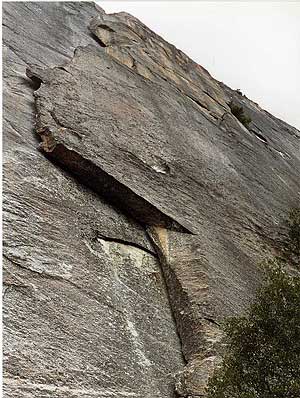
___And too, the ever-increasing extremism of
our climbing had me worried, as it seemed it could ultimately lead to only
one thing, asymptotically, nihilistically. As we hiked the slopes leading
to the climb, I began to turn inward, collecting myself for what I knew would
be undoubtedly the most serious lead of my life. We hardly spoke at all. Already
I sensed there was some kind of end to this all.
___So finally at our rendezvous atop steep brushy
pedestals, the immense left side of this monolithic hourglass-shaped flake
hung above, spiraling and soaring for nearly 400 feet on the Falls' East Buttress,
a much larger, vertical to overhanging wall, the whole awesome shimmering
image finally disappearing out of sight 700 feet above, everything in sight
consisting of the finest granite in Yosemite, not even one loose pebble all
those static feet somehow soaring above. At our backs was one of the great
vistas of Yosemite: the immense face of El Capitan, the Leaning Tower profile
and the Cathedral Rocks and Spires, all this from a unique angle and elevation.
___We could see the leader would start off above
a very disturbing chopper flake stuck in the ground, sharp, tall and upright---such
a chilling artifact! Climbing a 50-ft steep left-facing offwidth (5.10a/b)
to a very old single 1/4" compression bolt on the vertical main wall
awkwardly located behind his back, he would then encounter the imposing roof.
We figured clipping into this bolt correctly would be a really unique, irritating
problem, as the leader has to then spin around in the opposite direction while
tenuously leaving the offwidth to face and then instantly undercling, the
six inch roof crack, without any starting footholds and one's center of gravity
several feet below the underclinging edge, stuffed under the 4-ft thick roof.
The bolt had been put there near all these wide cracks for Kamps' desperate
aid lead of nearly a decade before. Arranging the spin successfully, the leader
would then strenuously climb this dead vertical feature to the left---maybe
15 ft to the one and only foothold. It was a poor slanting polished edge,
where nowadays he would put in modern protection for wide cracks, with the
roof continuing left another eight feet more.
___Underclings
are climbed not by simply putting your feet right below your hands and pulling
like hell, but by an artful process of complex shifting rhythmic balance and
great fluid power, picking out small smears---some low, some very high, as
there is always a "best place" on natural rock---on the main wall
for the feet, and actually moving quickly in a very expressive, surprisingly
set-and-release sort of way to avoid the omnipresent issues of a self-imposed
and simplistic energy crisis. Almost always this is the secret to underclings,
not allowing yourself to get locked up by the basic position but using speed,
rhythm, stemming, friction, as ghastly, tenuous and contradictory as that
might seem at the moment, especially if one's hands have to be far above one's
body.
___From the one little rest edge that we could
see from below, the leader would resume this underclinging and continue left
to turn the corner. He would convert to relentless liebacking of the edge
which at this point has now become, weirdly, a delicate white fin in a region
of the climb that is smooth as glass from serving as a water course since
time out of mind. Looking up I really worried I would break the fragile fin
off pulling hard on it, so I knew I would have to try to modify my use of
it to prevent disaster on lead by reaching deeply around it to reduce leverage,
spending even more precious energy in an even weirder climbing posture.
___I could not assume anything; it was all new
country. Ascending this feature for about 10 ft, we thought the leader finally
might be able to swing into an overhanging offwidth and stance on top of the
fin. At this point, at least 30 ft of rope would be out from the old single
1/4" bolt located well below and far to the right under the roof. That
bolt is perhaps 40 ft above the chopper flake and the ground a little further.
A fall from just left of the rest edge would mean a savage pendulum back towards
the chopper flake and any higher up, a cratering free fall to the ground.
I thought the worst thing that could happen to me would be that I would live
if a fall occurred. Such situations did exist to some extent already in Yosemite
cracks, but only rarely and not to this extreme. The incomparable ascent of
the Twilight Zone by Chuck Pratt had established a somewhat similar peril,
with the Zone's chopper flake smiling just below the second pitch crux and
the twenty-five feet of hard 5.10d overhanging offwidth above. Many of Chuck’s
other ascents presented the same issue: to ascend them you had to be ready
to leave everything behind and wriggle through some spiritual portal of terrible
beauty and rhythm, hopefully emerging cleansed, transported and living.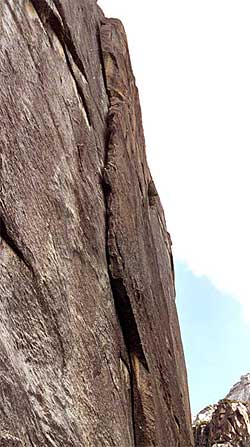
___Again looking up, we saw that from the offwidth
stance on top of the fragile fin, the climbing although more conventional
would be still quite significant, overhanging, and could easily become the
cause of a disastrous fall for a tired or uncareful leader, oblivious on some
level, tricked by its subtleties, trying to gun for the safety of the belay
spot. From below, it was not clear how to protect this section at all---there
was still just this wide wiggly crack. It looked to be about 5.10c by itself
and clearly could catch your knee in its throbbing variations. It soars upwards
at least 40 feet to where it lessens eventually to the belay stance, a glistening
lap-like basin in the dihedral where I would clearly be able to place the
anchors. From the ground we could see the climbing continues up more gorgeous
rock for two radiant and elegant 5.8 pitches to the top of this very astounding
steep slab and its sharp freestanding summit.
___When I began that day, I swarmed up the initial
offwidth and executed the weird rotations by the bolt, aggressively went to
the rest edge in the middle of the undercling, hung out for a brief moment,
but then suffered a violently urgent desire to get the hell out of there!
I was not ready for it. The climbing up to this point was of a completely
different type and the contrast posed a challenge in itself. Although I knew
that the problems would begin very abruptly, so stoutly, alarms nonetheless
screamed in my head. I was hardly warmed up, flashpumped even. It felt so
hideously committing, so repulsive, so strenuous, so tense, and so very dangerous.
Too many questions, too many feet of very hard rock above. It was a new, higher
level of climbing problem, unconventional, far less structured, and had little
comparison to any of the great test pieces I had already accomplished. And
I was a very careful climber, having only taken a couple of insignificant
leader falls in my eight-year career.
___Knowing to organize all my concerns in order
to cope and climb through each of them, I tried to make a mental list. For
one, I still worried about that fin further up breaking off in my hands---we
could see it from the ground and it seemed really extravagant and weak. I
was very doubtful after taking this first feel, that I could last the entire
undercling and then the lieback and still be able to swing into the offwidth
in control, even though the fin had a good top to it. I tried to remain optimistic
and not to picture myself rocketing off the lieback while I would try to enter
the slippery offwidth cleanly and statically. And too, would the offwidth
provide the stance necessary or deny me, sending me to certain doom? Just
getting to the roof had been significant, and negotiating the bolt clip was
a nasty paradoxical mental puzzle in the midst of big power moves, so perfect
planning had been an absolute necessity to avoid becoming upset, wasting time
and energy. And we worried about this bolt since it was very old and a scrawny
little 1/4" compression unit.
___So I scrambled back to the beginning of the
roof at the top of the first offwidth, nauseated, my mind spinning, planning
on probably retreating, my party below watching me in silence, oppressed as
well, but differently. I knew then that my hands would be horribly empty forever,
unless I risked everything, my life. I saw that I would not be able to solve
this riddle of my youth: who was I really and what was this world? And so
now I would be lost. I had come to that deadliest and most crucial moment
in a climber's life and thinking. I thought I could only answer these big
emotional and spiritual questions in terms of this one climb, so to retreat
now was also a major undertaking---it meant my complete demoralization and
the trivialization of all eight years of my hard climbing and my search and
yearning for true integrity.
___My partners were Rick and Mike, about on par
with each other as intermediate climbers. I grew up in a neighborhood in Berkeley
where Mike also lived and we went to the same school. In childhood, Mike and
I had an uneasy acquaintance, compounded by all the knowledge we had of each
other's grimy boyhood struggles. He was a year older, was nervous and grasping
and I think had problems at home. In 1971 he was still bony, and sharp, and
still had trouble concealing his belief that everyone including me thought
too highly of ourselves. I imagined he planned to be around when at some point,
defeated at last, I finally would realize he was oh-so-right and I was wrong;
and perhaps then he would be able to stand on top of my vanquished body, his
life finally better from another’s loss, and his big questions somehow
but speciously answered. Even though in his way he was still paradoxically
a Camp Four buddy or at least we were still somehow connected. After all he
had known me when we were little, but Mike didn't grasp fully what I had been
doing since, and what calls I was now trying to answer. I think this might
well have been the only climb he and I did although Mike went on to climb
in the Valley for some years afterwards. Rick at least had been a partner
and very close new friend. He was a very kind considerate larger guy for whom
climbing was difficult and was already more of a social phase than a crazy
religion. He became a hotel manager later on. These two men came along because
the puzzle of my life required I be on this major quest with no real competitors,
only friends and hopefully, neutral parties, and enough bodies to handle my
likely emergency. And guys that could keep our efforts a secret until the
experience was complete.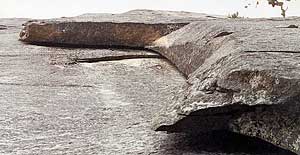
___What a predicament I was in as I strenuously
hesitated and stewed back at the start of the roof! My anguish was rapidly
starting to affect my overall condition. My whole climbing career was in front
of me at that moment. I lashed at myself with this question: was I really
going to do IT or was I going to be just another one of many who climbed in
the Valley for a while, undistinguished, and then forgotten, left to bumble
through the rest of a dim life empty-handed in some big spiritual way. I had
seen many meet this fate already. Mike was on the ground looking up thinking
what I knew he was thinking, I thought. And back in camp, there would be others
who would surely come in my place one day; they had swarmed over other projects.
But fretting there at the start of the roof, I still deeply believed that
I was really talented and I still believed this climb was my kind of climb,
so I could not give up either, I could not let go, although release from this
horrendous thing beckoned me, was practically required. Now after nearly a
decade of rigorous Valley experience, I clearly recognized how dangerous this
was going to be. But I began to feel I might reach even further into myself
just then and climb deeper than the danger itself, far deeper than I had ever
before, and out of some kind of ultimate love. I wanted to be on the inside
of the art. I believed this was probably my way in forever, and finally I
acknowledged that perhaps it was the only way in that would come up for me
ever. It seemed already that the meaning of this event would extend through
the rest of my life however I played it.
___So, having already climbed part of it back
and forth and lingered away, I conned myself into at least taking another
feel, and so swung up into the undercling once again from the first offwidth
with devised calmness, knowing that I might have squandered too much energy
already. I gained the sloping foothold far more cleverly and easily this time,
really surprised and encouraged by a new intuitive much bolder approach, and
so stayed there briefly in a poor but dramatic rest position, strangely leaning
nearly horizontally to the left on my one foothold, a right arm and foot loosely
up in the roof crack high above. It was supposed to be just a light-hearted
second look with retreat the likely result again. But quickly, an absolutely
blind determination built in me as I found myself seriously focusing---almost
as if in a bubble of my own, sensing for the first time a secret tunnel for
me up through this terrifying situation and that I might overcome the hideous
nausea of defeat and nothingness I knew all too well from other climbs. By
having familiarized myself with this segment of the climb, I could see more
in it, feel more recruited and powerful with it and it was becoming easier.
And I continued to hear the call.
___Finally, at last centered and willing to leave
the ordinary world in search of the answers and extreme beauty within this
place, I ferociously pulled back up into the undercling, swung around the
corner, delicately liebacked the ivory-smooth fin and wall to the rest pod,
oh so carefully finding I could, yes, slide in. And there I moaned for a few
moments. Hearing me, my party called up through the quiet, warm alpine air,
not quite understanding that for a brief time, I had left them and this valley
and this life, as many had before me, in obscure spots upon the rocks, lands,
and oceans of the world since time out of mind.
___Here I had begun to feel my hands just starting
to weaken and open up as I pivoted into the wild rest spot. The athletic,
cardiovascular aspects of the whole effort were incomprehensibly massive as
well. Nor was it over, as I knew the next 25 feet hung above me, threatening
to take all this away by dashing me on the ground absurdly. Getting these
final feet actually protected still had to take place somehow from the pod
and above, although at first I did not even care, the situation was so extreme.
All protocol had gone by the wayside for the special needs of this place.
I eventually discovered the only protection possible at this rest was a bong
placed endwise. This piece I hauled up from the ground by pulling slack from
my lead rope, abandoning its protection such as it was for the moment as if
I was unroped, and feeding it down to haul from the rest stance. Leading something
like this with a separate second haul line would have been a hideous complication
I could not accept beforehand. Putting the bong in was not easy as it was
below my waist and the result was quite questionable, maybe ludicrous. The
waterpolished overhanging stance on the fin kept me crowded to the crack,
nearly unable to hammer. Once I got it in to protect myself, I think I rested
for at least an hour, maybe even more.
___I was stripped of nearly all my powers but
still my training saw me through. Eventually clarity returned in rest although
my feet stuck in painful offwidth positions, had been falling asleep. Finally
climbing this last section, I was now clearly, completely unprotected and
would have grounded out, perhaps without even so much as a swing. I was never
more impeccable in my life, essentially unroped 70 feet off the ground doing
5.11, going even higher. Fortunately I had a long solid history of unroped
solo ascents and speed climbing to support me then in this culminating effort.
The visitation of sparkling images, moments of total power from those past
climbs came to me as I ecstatically ascended the final hard section to the
lap-like polished basin ending the lead.
___Gaining the belay nook, my experience was
flooding, ultimate, fervent religious gratitude. The great change had finally
come to me. It was not just that I was alive. Bestowed upon me, were the immortal
gift of this ascent and the brief visitation of enough power and courage to
make it and live for that moment in such seemingly limitless grace, clarity
and impeccability. I did not feel exalted and huge; I felt merely to be a
pure light-filled conduit to the event, transparent, humbled, and hardly distinguishable
from the rock itself, simple and cleansed, in a home like only that in a dream.
My partners were floored absolutely, realizing that something both horrific
and transcendent had just taken place. When the bolt was drilled, the belay
arranged and they eventually got going up my line, they couldn't follow the
lead at all but ultimately had to Jumar. Trying to access the undercling from
the offwidth immediately defied them, even though we used double ropes and
belays for their attempts. They despaired and did not fully comprehend what
they had seen, but wanted to find it too.
___When we gained the sharp Hourglass summit
in the warm dark, Mike was the first to reach me. Sitting next to me cloaked
in night air, he quietly told me that until now he had believed that I was
not as good as I thought I was, that there had been a lot of negativity working
between us and he was apologizing for it, that the ascent was unbelievably
hard and brave. I told him I knew this too, and it was okay, we were all okay,
it had been miraculous, and thank you for being honest and coming along and
being with me and we were together in this and now we have been given the
answer and it would be different from now on. I still felt immaculately void,
a plain vessel washed by a force, huge and beyond me, and my heart lay open
but strong. The world seemed a miraculous and mysterious place and I found
myself now peaceful, a deep and small part of it.
___In the blackness, we made a wild rappel bypassing
the usual airy hanging tree by tying topes together reaching the ground on
the other side by knot transfer, the exact and familiar spot where I had begun
my Yosemite climbing career, nine years before. We were not prepared to bivy
at all, but did anyway for a long hike down the huge, steep talus and woods
in the night without lamps would be deadly. More significantly I think all
three of us felt something huge had happened to us and to return right away
to the "world" would have been to also abbreviate and then end it,
allowing it to become just another illusion, this treasured state, all those
many years ago. The next morning we jumared and cleared the single line rappel
and left.
___Here was my last major climbing achievement.
I left the Valley a day or so later, got buried in my construction career
and never really returned with the same fervor. Although I did climb many
very hard routes in following years and climbed perhaps better than ever with
a freer heart, and now have even returned to serious modern climbing in my
fifties, I was set free so long ago, to go ahead, have a bigger life, to start
to take in a broader messier world, to try to be effective in that larger
wildly hopeless place that seemed all so complex, troubled and wrong and to
which I had had no sense of belonging. After all, I had been there, to what
I thought was maybe, the other side or at least had found one big answer within.
This was also the challenge that faced Beat philosophy.
___Looking back, I suppose my fulfillment was
to have seen that yes in this world, there was something more inside it all,
past mundanity, which if somehow reached, took one in or took one back rather,
as Blake has said. I believed that embedded in the physical grace of climbing,
was a great natural truth, perhaps not another realm such as a heaven. 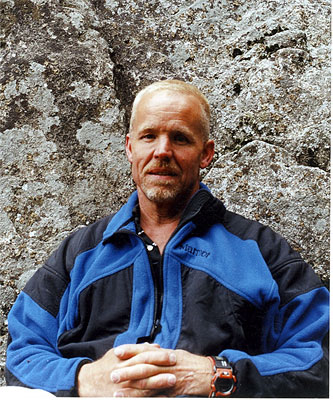 This
truth was understood in those moments when everything was impeccably risked,
climber approaching a reductive state in which his "subject" and
the rock's "object" became indistinguishable, intertwined. The rock
and climber weaving together, as John Gill, Castaneda, and Merleau-Ponty have
all written. This bond, chiasm and truth was physically experienced, rather
than theorized by mere cognitive or religious means, and so was only found
hidden inside activities like deep climbing itself and perhaps yielded no
other answers but itself and the simple fact that we are of this earth and
our manner of perceiving is inextricably bound up with it. But such joy! Just
as we know that a painting is a visual experience and cannot be rendered in
or fully experienced by a written description, so it is with climbing---one
must climb, and climb quite hard, to find and have this deep aesthetic union
in the living world, to be englobed, or intertwined with the mother world,
once again, and perhaps over and over again. This would be our very powerful
defense against the nauseating prospect of complete Nothingness and crucial
isolation that otherwise we each are caught up in and which, raw and unvarnished,
I faced so long ago.
This
truth was understood in those moments when everything was impeccably risked,
climber approaching a reductive state in which his "subject" and
the rock's "object" became indistinguishable, intertwined. The rock
and climber weaving together, as John Gill, Castaneda, and Merleau-Ponty have
all written. This bond, chiasm and truth was physically experienced, rather
than theorized by mere cognitive or religious means, and so was only found
hidden inside activities like deep climbing itself and perhaps yielded no
other answers but itself and the simple fact that we are of this earth and
our manner of perceiving is inextricably bound up with it. But such joy! Just
as we know that a painting is a visual experience and cannot be rendered in
or fully experienced by a written description, so it is with climbing---one
must climb, and climb quite hard, to find and have this deep aesthetic union
in the living world, to be englobed, or intertwined with the mother world,
once again, and perhaps over and over again. This would be our very powerful
defense against the nauseating prospect of complete Nothingness and crucial
isolation that otherwise we each are caught up in and which, raw and unvarnished,
I faced so long ago.
Twenty-nine
years later, I sat at the base of the great climb
at the age of 51 during a light snow storm in March 2000.
info@WideFetish.com
